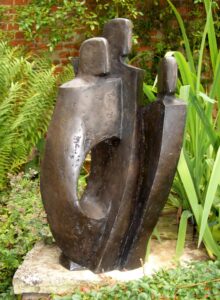My garden sculpture over the years has been placed in small town gardens, vast country estates, suburban patios and also in roof gardens. It is also satisfying to know that several pieces have been placed in the quiet gardens of hospitals, a setting which gives enjoyment to patients and staff alike.
Garden sculpture has long been part of the tradition of classical estates in Britain as well as in Italy. Indeed many of us have enjoyed visiting the gardens of stately homes and seen beautiful displays of sculpture placed in a precise and formal way. These gardens emulated those of the Roman period with collections of statuary depicting mythological subjects such as gods and goddesses, ancient heroes and warriors as well as fantastic creatures.
However, this way of siting garden sculpture has long been superseded by a more informal approach as garden design has developed over the years to produce the contemporary schemes which are popular today. Owning a garden sculpture nowadays is not just the prerogative of the aristocracy and the wealthy and we can all find an artwork which not only pleases us aesthetically but also suits our pocket. Although garden centres may be your first port of call, most of these outlets sell mass-produced pieces of little artistic merit and often of low quality, so if you are looking for something which is more exclusive it is best to choose the work of a sculptor whose work you admire. You can choose from a range of different materials which will withstand the rigours of the weather from foundry cast bronze and resin casts to metal, ceramic and stone. Many people particularly enjoy the qualities of wood, but this is bound to deteriorate outdoors over the years, so it is best to opt for a more lasting material.
If you are thinking of buying a garden sculpture, take a walk round your garden, trying to imagine where best to site it. You may wish it to be the main focal point in the centre of a flower bed or at the end of a path; or it could add interest to an area where plants find it difficult to survive. Take a long view and even go into the house to view your chosen area, selecting a spot where the sculpture would be seen to advantage. Watch how the sunlight moves across the area from early morning to late in the day, which will give the sculpture entirely different effects.
In selecting a site you will also need to look at the background of the proposed sculpture; it may be a brick wall, an area of dark foliage or a long view. You need to look for a contrast in the patination or colour of the work, so that it can be seen properly from a distance. Its reflection can also be taken into account when placing a garden sculpture by a lake or pond, and occasionally my clients have placed one of my pieces in front of a mirror, which creates an entirely different effect. My sculpture comes in a variety of different patinations, from the silvery-grey of aluminium to the verdigris or dark colourings of bronze, through to the vibrant rust hues of iron.
 The scale of a sculpture is also important in relation to the site; a three foot piece on a patio which will always be viewed at close range will be perfectly suitable, but maybe lost from view in a large flower bed. However you could make a feature of having a group of small pieces which you come upon as a surprise in a larger space. Consider both the height and the width of the selected piece, and don’t forget to look at its depth as well, particularly if it is to be viewed from all directions. Most well-designed sculpture has been created to be viewed three-dimensionally, so that there is continual visual interest, as you walk around it.
The scale of a sculpture is also important in relation to the site; a three foot piece on a patio which will always be viewed at close range will be perfectly suitable, but maybe lost from view in a large flower bed. However you could make a feature of having a group of small pieces which you come upon as a surprise in a larger space. Consider both the height and the width of the selected piece, and don’t forget to look at its depth as well, particularly if it is to be viewed from all directions. Most well-designed sculpture has been created to be viewed three-dimensionally, so that there is continual visual interest, as you walk around it.
As a sculptor I am always happy to advise as to the selection and placement of one of my garden sculptures so that you make the most of the site, and be happy with your purchase for years to come.

